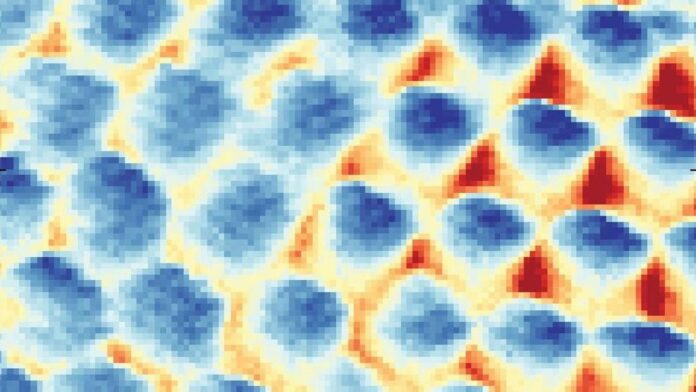Electrons are typically seen flitting around their atoms, but a team of physicists has now imaged the particles in a very different state: nestled together in a quantum phase called a Wigner crystal, without a nucleus at their core.
The phase is named after Eugene Wigner, who predicted in 1934 that electrons would crystallize in a lattice when certain interactions between them are strong enough. The recent team used high-resolution scanning tunneling microscopy to directly image the predicted crystal; their research is published this week in Nature.
“The Wigner crystal is one of the most fascinating quantum phases of matter that has been predicted and the subject of numerous studies claiming to have found, at best, indirect evidence for its formation,” said Ali Yazdani, a physicist at Princeton University and the study’s senior author, in a university release.
Electrons are mutually repulsed: they like to steer clear of one another. In the 1970s, a team at Bell Laboratories created an electron crystal by spraying the particles on helium, and they observed the electrons behaving like a crystal. But that experiment was stuck in the classical realm. The recent experiment produced a “true Wigner crystal,” according to the team, because the electrons in the lattice were functioning as a wave rather than as individual particles stuck together.
Wigner theorized that this quantum phase of electrons would occur due to the particles’ mutual repulsion, not in spite of it. But it would only happen in very cold temperatures and in low-density conditions. In the new experiment, the team put electrons between two graphene sheets exhaustively purged of material imperfections. Then, they chilled the samples and applied a magnetic field perpendicular to it. The highest magnetic field strength was 13.95 Tesla, and the lowest temperature was 210 millikelvin. Putting the electrons in a magnetic field further confines their movement, boosting the chances that they’ll crystallize.
“There is an inherent repulsion between the electrons,” said Minhao He, a researcher at Princeton University and co-first author of the paper, in the same release. “They want to push each other away, but in the meantime, the electrons cannot be infinitely apart due to the finite density. The result is that they form a closely packed, regularized lattice structure, with each of the localized electron occupying a certain amount of space.”
The team was surprised that the Wigner crystal remained stable over a longer range than expected. At higher densities, though, the crystalline phase gave way to an electron liquid. Next, the researchers hope to image how the Wigner crystal phase gives way to other phases of electrons under a magnetic field.
These are heady days for studying exotic materials, from scrutinizing the second sound of heat to time crystals that persist longer than ever before. By probing matter at its extremities, physicists will better understand the stuff that makes up our universe and the enigmatic laws they obey.
A version of this article originally appeared on Gizmodo.


